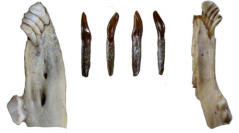

 Comptes Rendus Palevol
3 (3) - Pages 179-189
Comptes Rendus Palevol
3 (3) - Pages 179-189The Early Pliocene Mabaget Formation (5.3–4.5 Ma), Tugen Hills, Kenya, has yielded remains of the African tragulid Hyemoschus aquaticus, which is today confined to rainforests of West Africa and the Congo Basin as far east as western Uganda. The same unit has also yielded a peafowl, Pavo sp. The Mabaget Formation has yielded early hominid fossils variously attributed to Australopithecus praegens or Ardipithecus ramidus. This sedimentary deposit joins the list of very early hominid units that preserve evidence of forest in the vicinity of the basin at the time of deposition. This discovery adds weight to the suggestion that the earliest hominids inhabited well wooded to forested regions rather than open country. It now seems more likely that bipedalism evolved in wooded to forested ecosystems and was, for several million years, linked to arborealism and that only after it was perfected did hominids spread into more open environments as fully functional bipeds. If so, then there is no reason to postulate a quadrupedal ‘knuckle-walking’ stage in the evolution of hominids.
Tragulidae, Peafowls, Tropical forest, Palaeoenvironment, Early Pliocene, Kenya